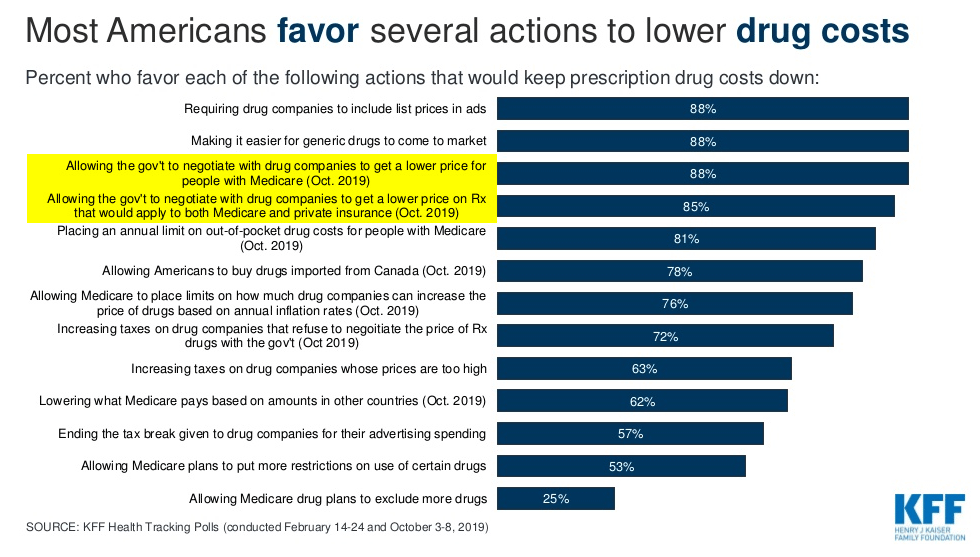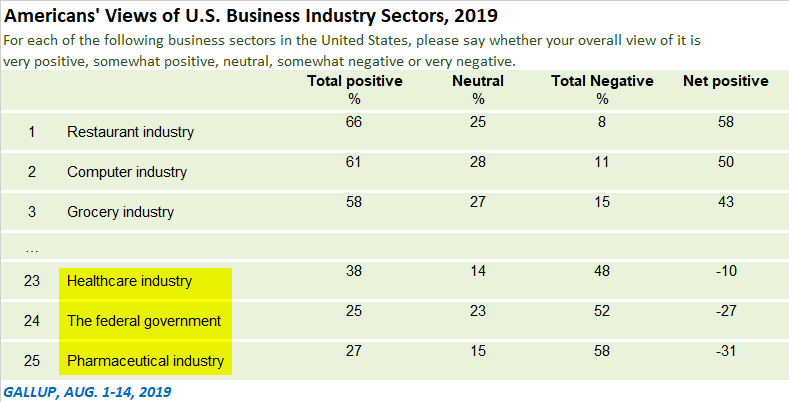- Healthcare has been affected by the growing thrust towards regulation to reduce costs.
- Biotech and pharmaceutical valuations have been hurt as efforts to control drug prices intensify.
- Improving risk appetite is nudging markets higher and biotechs will participate as well, although gains will have a ceiling.
- Biotechs have a short window of opportunity as an improving risk environment and a strong interest in acquisitions, over $9 bn in the past ~1 month, will assist biotechs to participate in the rally.

Biotech and pharmaceutical groups have struggled immensely over the past two months as unique issues affecting the industry have become more dominant. The general market skittishness over rate policy and tariffs have also contributed to the woes. However, with the broader market tenor improving following a benign Fed policy, a period of US-China trade detente, an expectation of steady economic data, and earnings that are thus far mostly meeting expectations, it will be interesting to see how healthcare will perform, and specifically biotechs. We believe if the broader market continues to rise, biotechs will participate. However, it most likely won’t be an unbridled rise as the political and regulatory landscape, unique to the healthcare sector, will continue to frame the sector’s valuation and limit gains. But all is not lost in the near-term and there are opportunities ahead.
Healthcare – A Sector In Transition
Healthcare is a leading public interest issue, due to its personal nature and direct impact on household finances. Consequently, there are numerous bills and proposals in Congress attempting to address the issue. At the same time, the healthcare reform debate continues to intensify as the election season picks up pace.
One such bill, Lower Drug Costs Now Act of 2019 (HR3), is expected to pass the House by end of October or early November and will allow the government’s Centers for Medicare and Medicaid Services ((CMS)) to directly negotiate lower prices on 250 of the most expensive drugs each year and apply the discounts achieved to all private US health plans systemwide. Pharmaceutical companies that are unable to agree will be required to pay a penalty. The Congressional Budget Office ((CBO)), a non-partisan government agency, estimated that the plan will save Medicare $345 billion over a decade. The fate of the bill is much less assured in the Senate. However, another bill in the Senate “Prescription Drug Pricing Reduction Act of 2019,” proposes adding an out-of-pocket maximum for Medicare beneficiaries and penalizing pharma companies for raising prices faster than inflation. CBO estimated the bill will save taxpayers $85 billion over 10 years.
These are just two of many such bills and proposals, along with major healthcare reform, like Medicare for All, being adopted in the platforms of presidential candidates. All of this contributes to underscoring the growing momentum for healthcare reform, and correspondingly growing uncertainty for healthcare investors.
Innovation Vs Lower Drug Prices
In a Kaiser survey in October 2019, most participants (85%) were found to be in favor of federal regulation and direct negotiations by government entities to lower drug prices for Medicare and private insurance.

The key issue in the pursuit of lower drug costs is to avoid stifling drug innovation, which is driven by the strong appeal of profits. The industry remains adamant that any form of price adjustment regulation will affect innovation. On this issue, the public is indeed cautious about the impact of such price controls on innovation, as an earlier Kaiser survey showed the support for price negotiations dropping to 31% if it hurts industry innovation.
Bottom Of The Heap
The writing for the healthcare industry has been on the wall for some time. We are on a path of change towards rising government control of the healthcare industry. The legislative efforts are just a consequence of a growing public outcry of a relentless rise in healthcare costs and premiums. The pharmaceutical industry’s reputation with the public has suffered immensely, where it’s now at the bottom of the 25 groups in an annual Gallup poll on positive public image.

The healthcare industry is just above the Federal Government in its popularity. This is just an indication of how adverse public opinion is towards healthcare and the driving force behind various bills and proposals.
Pharmaceutical companies are exposed to a persistent and urgent regulatory threat to controlling drug prices. But it’s not just these two industries in healthcare. If the healthcare sector goes through a major restructuring in 2021, after the Presidential elections, it can have profound implications for many groups including medical systems, healthcare technology, medical products, hospitals, etc. The healthcare industry remains in transition and investors will have to continue factoring the risk and volatility that such a transition creates.
Implications For Biotechs
In any price control debate, pharmaceuticals are the worst placed, as they bear the brunt of such legislation. And consequently, the industry fights tooth-and-nail, at any change which diminishes its pricing power.
Biotechs typically have a high level of correlation to the fortunes of the pharmaceutical industry. However, biotechs are also affected by the overall market sentiment towards risk – whether it’s a risk-averse or a risk-friendly environment. Besides, biotechs also represent a target group for acquisition opportunities for pharmaceutical companies. At this moment of time, it is these two characteristics that provide a window of opportunity for biotech gains this year.
A. Risk-on Mode. The market has once again entered a period of risk-taking as near-term stress has diminished. The Federal Reserve has intervened twice, the US-China trade friction has ebbed for the moment thus reducing the possibilities of sudden tariff announcements, economic data has been both strong and weak thus suggesting that we are in a soft patch but not sliding into a downturn with every signal turning red. The unfolding third-quarter earnings season has been positive thus far, though it’s still early. As per Factset, of the 15% of the S&P 500 companies that have reported as of the end of last week, 84% have reported above expectations, which is above the 5-year average. By itself, the statistic is too broad, but it supports the contention that economic conditions are not in a rapid decline. Incidentally, this will be the third straight quarter of year-over-year negative earnings growth. So the negative earnings growth is not a surprise by itself, and in fact, helps in improving the chances of positive growth in 2020. The S&P 500 (SPY), the Nasdaq Composite (QQQ), and Dow Jones (DIA) have resumed their uptrend. Even the smallcap Russell 2000 (IWM) has firmed up, thus indicating a broader shift towards risk.
B. Acquisitions. A combination of scientific progress, subdued biotech valuations, and a push towards expanding product pipeline as a result of low in-house R&D return and a threat of legislation on drug prices is spurring pharmaceutical companies to ramp up the pace of M&A. Over the past 45 days, 5 transactions have occurred at an over $9 billion valuation. This includes purchases of Alder Pharmaceuticals (ALDR) by Danish firm Lundbeck, Dova Pharmaceuticals (DOVA) by Swedish firm Orphan Biovitrum, Ra Pharmaceuticals (RARX) by Belgian firm UCB, Achillion Pharmaceutical (ACHN) by Alexion Pharmaceuticals (ALXN), and privately held Semma Therapeutics by Vertex Pharmaceuticals (VRTX).
Conclusion
The Fed has intervened, the economy is not close to a recession even though it’s meandering through a slow patch, and a highly disruptive market element, the US-China trade friction, appears to have found a truce for another month or maybe two. This has allowed the stock market to be on more firmer ground. As the sentiment and risk appetite has improved the market is working on building a durable uptrend. Earnings season has not been a disappointment thus far and is improving confidence in the resilience of the economy. However, all this is held together by assumptions that there will be no ratcheting up of trade-related friction and that the Federal Reserve will maintain its realization of a tender economy and remain focused on supporting it.
The improving market risk profile and transaction activity provide an opportunity for biotechs, which have been hurt by regulation uncertainty, to move higher in a selective manner. Furthermore, biotechs recently declined sharply due to the ascendancy in the polls of Senator Warren, who has a Medicare for All plan that calls for a greater restructuring of the healthcare industry. To the extent that Senator Warren begins to lose her lead in the polls or modifies her healthcare plan to lower its impact, valuations for biotechs and pharmaceutical companies will be helped.
There are many promising biotech companies, which can benefit from a more favorable investment environment since a lot of the recent decline was due to the systemic risk factors. A few of them, which may be now or in the past be part of the Prudent Biotech model portfolio or the Graycell Small Cap portfolio, include Medicines Company (MDCO), Acadia Pharmaceuticals (ACAD), Arrowhead Pharmaceuticals (ARWR), Seattle Genetics (SGEN), Dicerna Pharmaceuticals (DRNA), Momenta Pharmaceuticals (MNTA), Deciphera Pharmaceuticals (DCPH), Reata Pharma (RETA), Apellis Pharmaceuticals (APLS), Zymeworks (ZYME), Karyopharm Therapeutics (KPTI), Arqule (ARQL), Radius Health (RDUS), Flexion Therapeutics (FLXN), and Tricida (TCDA).
The article was first published on Seeking Alpha.
